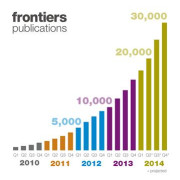- Science News
- Environment
- Soil dwellers thrive in between solar panels: Here are five Frontiers articles you won’t want to miss
Soil dwellers thrive in between solar panels: Here are five Frontiers articles you won’t want to miss
By Deborah Pirchner, Frontiers science writer

At Frontiers, we bring some of the world’s best research to a global audience. But with tens of thousands of articles published each year, it’s impossible to cover all of them. Here are just five amazing papers you may have missed.
Solar parks can house semi-natural grassland communities
Solar parks are sustainable ways to ensure clean energy. The ecosystems in which they are built are often sites that are excessively managed and affected by habitat destruction. This land management, however, also offers opportunity to restore or even create semi-natural grasslands. Researchers in France have studied 10 solar parks in the south of the country to examine plant community composition, soil biodiversity, and soil functioning under and outside of solar panels to test whether they hamper soil health. They have now published their results in Frontiers in Environmental Science.
Their results indicate that the microclimate under panels influenced the abundance of soil megafauna, fungi biomass, and bacteria. Plant communities under panels tended to be made up of more shade-tolerant species, which reduced plant diversity and vegetation cover. Between panels, however, the researchers found more trophic interactions than outside or under solar panels. This suggested a protection effect of panels between rows on the soil food web, allowing for the establishment of semi-natural grassland communities in solar parks.
Article link: https://www.frontiersin.org/articles/10.3389/fenvs.2023.1137845/full
Crying robots can trigger human support intentions
Human tears are loaded with meaning. They are a social signal that is intuitively understood and elicits support intentions from others. Researchers in Japan have developed a robot that sheds tears like a human. Writing in Frontiers in Robotics and AI, they examined whether the tears of robots have the same signaling function for conveying sadness that human tears have. They also investigated if robot tears made observers want to help.
Their results indicated that pictures that showed ‘crying’ robots were significantly more likely to be perceived as sadder than pictures that showed robots that weren’t crying. Robots with tears were also considered more helpless, which trigged observers’ reflex to lend support. The researchers also noted a perceived sense of closeness to tear-shedding robots. The study demonstrated for the first time that tears in robots may function as emotional and social signals in the same way as tears in humans do. Seeing robots cry may also have facilitated their humanization, the researchers said.
Article link: https://www.frontiersin.org/articles/10.3389/frobt.2023.1121624/full
Cooling down may be more effective than sitting down during half-time
For sportspeople, half-time is the chance to recover – something that usually happens while sitting down. But is sitting down in-between physical activity sets the most efficient way to boost performance in the second half? This question has been on the minds of researchers in Japan. In a study published in Frontiers in Physiology, they investigated the effect of cold-water immersion of the hands and forearms during half-time on intermittent exercise performance.
11 physically active men performed a cycling exercise protocol split into two blocks by a 15-minute break. During this break, some participants rested by sitting down, others immersed their hands and forearms in cool water. In the latter group, the researchers observed a higher mean power output in the second exercise block. Sports performers who’d cooled down also experienced a greater decrease in temperature and heart rate at the end of half-time. Compared to those who had rested sitting down, they also indicated that their perceived exertion rating was lower.
Article link: https://www.frontiersin.org/articles/10.3389/fphys.2023.1143447/full
Changing defibrillator design could help save lives
More than nine out of 10 people who suffer out-of-hospital cardiac arrests (OHCAs) do not survive. Rapid defibrillation is essential for potential survival and long-term quality of life of those affected. Lay responders play a crucial role in giving patients a chance of survival. The primary method by which first-aiders can deliver rapid defibrillation to OHCA patients is via the use of publicly accessible automated external defibrillators (AEDs). These machines are a safe and effective way for improving survival, even when their users had no training.
Now, researchers in Australia have tested how defibrillators may be used even more often by first-aiders. An easy way to do so might be to replace the currently used green-white design with one that favors the colors red and yellow, they write in Frontiers in Cardiovascular Medicine. They found that 73% of Australians preferred red-yellow defibrillator design and 88% favored red-yellow cabinet design. This design was considered as easier to identify in emergencies and may increase public willingness to use the machines, the researchers wrote.
Article link: https://www.frontiersin.org/articles/10.3389/fcvm.2023.1178148/full
Genomics training found essential for front-line medical professionals
Genomic technologies hold the key to faster and more accurate diagnosis of diseases, but the ambition of embedding genomic medicine in the diagnostic pathway requires involvement of front-line clinical workers. This is known as ‘mainstreaming’. In a study recently published in Frontiers in Genetics, researchers in the UK have investigated the level of competence and confidence of practicing nurses and midwives to support mainstreaming. They also analyzed nurses’ and midwives’ perception of the importance of genomics in the delivery of patient care.
Results indicated that all professionals appreciated the importance of genomics. However, the study also highlighted the very low fundamental knowledge of genomics and low confidence of healthcare workers that they could deliver such care as part of their day-to-day jobs. Upskilling of medical professionals is essential to help them understand the genetic aspects of their patients’ conditions, conduct the relevant consenting for genetic testing, and communicate confidently about potential treatments and implications, the researchers concluded.
Article link: https://www.frontiersin.org/articles/10.3389/fgene.2023.1125599/full
REPUBLISHING GUIDELINES: Open access and sharing research is part of Frontiers’ mission. Unless otherwise noted, you can republish articles posted in the Frontiers news site — as long as you include a link back to the original research. Selling the articles is not allowed.







